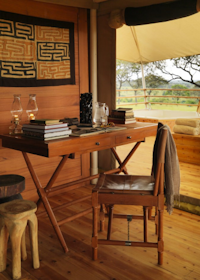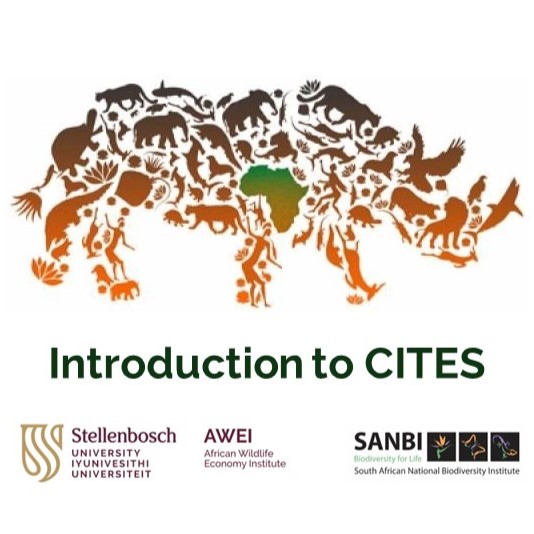CITES Module 9
9 Application of CITES measures in South Africa
In this module you will learn about the roles and operational modalities of the CITES Scientific Authority in South Africa vis-a-vis the Management Authority. This includes responsibilities at the national, provincial, and international levels.
Lecture
- Click on the image below to stream the lecture on OneDrive (19 min)
- You can also download the lecture for listening offline
- Take notes while listening
The Scientific Authority of South Africa (SAoSA)
From the National Environmental Management Biodiversity Act (NEMBA) 10 of 2004 as amended up to July 2013:
- 59. The Minister… must consult the scientific authority on issues relating to trade in specimens of Endangered species regulated by such an international agreement
- 60. (l) The Minister must establish a scientific authority for purpose of assisting in regulating and restricting the trade in specimens of listed threatened or protected species
- 60. (2) The Institute [SANBI] must provide logistical, administrative, and financial support for the proper functioning of the scientific authority
The Management Authority of South Africa
From the DFFE website:
- The department [DFFE] has been designated a CITES management authority with the responsibility of coordinating the implementation of the convention internally
- In terms of the South African Constitution the responsibility for the protection of fauna and flora, and consequently the control of the import and export of fauna and flora species, is vested in the provincial conservation departments. Provincial nature conservation authorities have therefore also been designated as CITES management authorities.
Learning resources - videos
- While watching these videos, reflect on the learning questions provided
- Take notes while viewing
CITES of Wild Fauna and Flora is currently underway in Sandton
- The second day of the Convention on International Trade in Endangered Species of Wild Fauna and Flora is currently underway in Sandton. For 10 days, the CITES COP17 meeting will tackle 62 different proposals coming from wildlife experts around the world, concerning some 500 species.
- Q: What year was this meeting and what outcomes impacted South Africa?
Game meat | Plans to formalise industry in SA
- The Forestry, Fisheries, and Environment department has extended its deadline for comment on its Game Meat plans. The aim is to ultimately formalise the industry in the country.
- Q: What are some key steps that need to be taken to formalise the industry and do any these have implications for international trade in wildlife?
Biodiversity Indaba | Efforts to protect SA's fauna and flora
- A conference on how best to protect the country's flora and fauna has kicked off in Johannesburg. Conservationists and academics will fine-tune programmes to protect plant and animal species. On Tuesday, President Cyril Ramaphosa will give the keynote address.
- Q: This conference launched South Africa's biodiversity economy strategy. What are the implications for international trade in wild species and the work of the Scientific Authority?
 Learning resources - readings
Learning resources - readings
- While skimming through these documents, reflect on the learning questions provided
- Also, download documents for future reference
SANBI Summary report on NDFs April 2017
- Non-detriment findings approved by the Scientific Authority are summarized in section 1. Progress with the publication process is also indicated in this section. Sections 2 and 3 list plant and animal species for which NDFs are currently underway.
- Q: Are links to full documents provided? If so, are these accessible? If not, how can they be obtained?
- In this Commentary, we summarise the current legal requirements for the collection and use of biodiversity material for non-commercial research purposes in South Africa, highlight the main challenges from the perspective of researchers and natural science collection curators and managers, and make recommendations for addressing the challenges identified.
- Q: What insights, in any, are provided about CITES permitting in South Africa?
CITES Implementation Report - 2015-2017 South Africa
- Article VIII, paragraph 7 (b), of the Convention requires each Party to submit to the CITES Secretariat a report on legislative, regulatory and administrative measures taken to enforce the provisions of the Convention.
Q: Are there sections of this report that could be updated?
- The sharp increase in the export of Lion skeletons from South Africa to Southeast Asia (especially Lao PDR and Viet Nam) from 2008 led to concerns that bones from wild Lions were being sold into the Traditional Asian Medicine (TAM) trade and thus negatively affecting vulnerable wild Lion populations.
- Q: How does the work of the Scientific Authority feature in this report?
 Learning resources - websites
Learning resources - websites
- While browsing these websites, reflect on the learning questions provided
- Also, bookmark websites for future reference
- This is an old page about CITES on the DFFE website.
- Q: Can you find any updated information on CITES on this website?
Scientific Authority - SANBI South Africa - Domestic measures | CITES
- This is the SANBI section on the Scientific Authority.
- Q: What information, if any, could be added to make this presentation more useful for stakeholders?
- Threatened Or Protected Species (TOPS) permit and registration application process for the carrying out of restricted activities in terms of the National Environmental Management: Biodiversity Act 2004 (No. 10 of 2004)
- Q: Is this the right place to go to to apply for a CITES export or import permit? If not, where does one apply for a permit?
Biodiversity Collection Permits in South Africa – SANBI
- These web pages are an attempt to guide prospective collectors/ researchers to make contact with the relevant issuing authorities to ensure that they obtain all the necessary permission and permits before any collection of natural genetic resources/ biological material/ specimens takes place.
- Q: Is this permitting system connecting to CITES? If not, could it be connected?
What You Need To Know About Wildlife Permits – Helicon
- There are a number of permits one has to take into consideration when dealing with game capture. The most common permits used are Import, Export, TOPS (Threatened Or Protected Species), Capture, Standing, Registration, Game Dealer, Wildlife Trader and AIS (Alien and Invasive Species) permits.
- Q: How does the information on this page relate, if at all, to CITES permits?
Let's continueGo to Module 10 Discussion on the role of the Scientific AuthorityGo back to Module 7Go back to the introduction |
Get updates by email
Through impactful research, stakeholder engagement, and professional development, AWEI is supporting the wildlife economy across Africa. Please subscribe for occasional updates on our work and forthcoming events.
Sign up for a quarterly dose of AWEI insights
In a complex and changing world, AWEI generates strategic ideas, conducts independent analysis on wildlife economies, and collaborates with global scholar-practitioners to provide training and expertise for biodiversity conservation, climate resilience, and inclusive economic opportunities in Africa.

